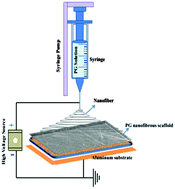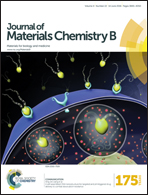Durable keratin-based bilayered electrospun mats for wound closure†
Abstract
A bilayered nanofibrous scaffold with rapid wound healing properties is found to be suitable for tissue regeneration applications. The objective of this study is to reveal the fabrication of a poly(3-hydroxybutyric acid) (P)–gelatin (G) nanofibrous mat through electrospinning, with a horn keratin–chitosan-based biosheet (KC) as a bilayered nanofibrous scaffold. The mupirocin (D)-loaded horn KC biosheet (KCD) acts as the primary layer over which PG nanofibers were electrospun to act as the secondary layer. It is shown that this engineered bilayered nanofibrous scaffold material (KC–PG) should fulfill the functions of the extracellular matrix (ECM) by elucidating its function in vitro and in vivo. The bilayered nanofibrous scaffold was designed to exhibit improved physiochemical, biological and mechanical properties, with better swelling and porosity for enhanced oxygen permeability, and it also exhibits an acceptable antibacterial property to prevent infection at the wound site. The bilayered nanofibrous scaffold assists in better biocompatibility towards fibroblast and keratinocyte cell lines. The morphology of the nanofibrous scaffold aids increased cell adhesion and proliferation with cell material interactions. This was elucidated with the help of in vitro fluorescence staining against both cell lines. The bilayered KCD–PG nanofibrous scaffold material gives accelerated wound healing efficiency during in vivo wound healing. The results showed the regulation of growth factors with enhanced collagen synthesis, thereby helping in faster wound healing.


 Please wait while we load your content...
Please wait while we load your content...